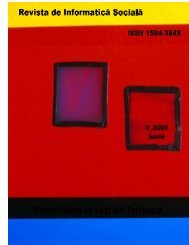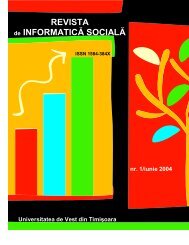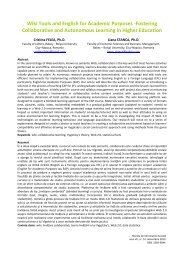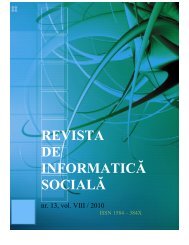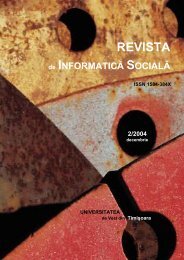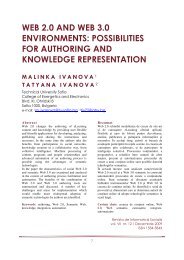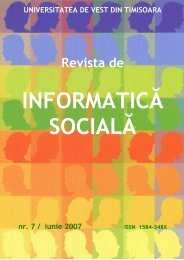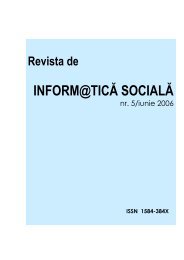No 14 - Journal of Social Informatics / Revista de Informatica Sociala
No 14 - Journal of Social Informatics / Revista de Informatica Sociala
No 14 - Journal of Social Informatics / Revista de Informatica Sociala
Create successful ePaper yourself
Turn your PDF publications into a flip-book with our unique Google optimized e-Paper software.
Sli<strong>de</strong>ShareFlickr1.72.13.62.1WikipediaMySpace12.112.323.224.920092008YouTube2127.20 5 10 15 20 25 30Figure 6 - Percentage <strong>of</strong> stu<strong>de</strong>nts who upload original content on specific sites(N=1086 for 2008, N=1123 for 2009)DiscussionThe results we have presented are obviously limited and they cannot pretend to sustain generalreflections. However, if consi<strong>de</strong>red in comparison with other similar research reported in theinternational literature 4 , they seem to point in a common direction, as far as the relationshipsbetween university stu<strong>de</strong>nts and social media is concerned. The new generation <strong>of</strong> stu<strong>de</strong>nts showsvery high rates <strong>of</strong> use <strong>of</strong> the computer and <strong>of</strong> connection to the Internet; on the other si<strong>de</strong>, wecannot infer that this use is automatically related to high levels <strong>of</strong> technological expertise and digitalliteracy. In particular, what are usually consi<strong>de</strong>red as the more advanced features <strong>of</strong> Web 2.0, areknown and commonly used only by a very limited minority <strong>of</strong> subjects.One <strong>of</strong> the most salient evi<strong>de</strong>nce coming out <strong>of</strong> our research was related to what we labelled as the“Facebook phenomenon”; there was an abrupt increase, between 2008 and 2009, in the number <strong>of</strong>subjects making use <strong>of</strong> Facebook, that corresponds also to a more general trend at the national level.The fact that, anyway, other applications still remain largely unknown to a great majority <strong>of</strong> oursample, and that among the least known we find sites for social bookmarking and sharing contentsuch as Delicious and Sli<strong>de</strong>Share, or for microblogging as Twitter, may lead us to reflect moreaccurately on the actual impact <strong>of</strong> the Web 2.0 in our sample.Like all general labels, talking <strong>of</strong> “social media” or <strong>of</strong> “Web 2.0” may be useful as it allows us torefer to a broad set <strong>of</strong> phenomena that present similar characteristics. On the other si<strong>de</strong>, thisgeneralization can also masks the presence <strong>of</strong> some specific differences between applications.Talking about the educational relevance <strong>of</strong> social media, these differences can, however, assume aspecific importance. Future research should perhaps further investigate these issues, looking morein <strong>de</strong>pth at the different activities that each specific application can support, and how this can belinked to its diffusion. Interesting suggestions in these sense can be found in the already mentionedresearch by Kennedy et al. (2009), who have classified the type <strong>of</strong> activities subjects can perform onthe Internet in five broad categories:4 Other evi<strong>de</strong>nce can be found for example in Bullen et al. (2009) for what concerns Canada, and in Nagler and Ebner(2009) for what concerns Austria. See also Hargittai (2010)



